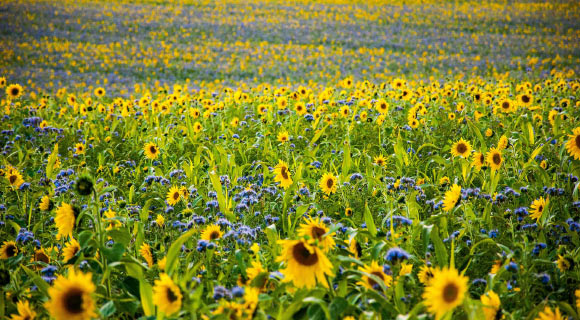Typically, plants grow in crowded environments, where neighboring plants shade each other while competing for light. The presence of neighbors varies over space and time, and plants have evolved the ability to detect neighbors and grow away from their shade. While it is generally acknowledged that these responses aid plants in increasing their individual light exposure, it is not clear how they manage to find collectively beneficial solutions. In a new study, physicists from Tel Aviv University and elsewhere focused on the spontaneous self-organized pattern formation in groups of sunflowers that are mediated by shade avoidance. Their analysis revealed that circumnutations — inherent plant movements — provide random perturbations that conform to a bounded random walk.
While circumnutations are ubiquitous in plant systems, and generally associated with exploratory movements, a quantitative understanding of their role is elusive. Nguyen et al. report, for the first time, their role in facilitating an optimal growth pattern for a crowded group of mutually shading plants. Image credit: Manuel H.
“Previous studies have shown that if sunflowers are densely planted in a field where they shade each other they grow in a zigzag pattern — one forward and one back — so as not to be in each other’s shadow,” said Tel Aviv University’s Professor Yasmine Meroz.
“This way they grow side by side to maximize illumination from the Sun, and therefore photosynthesis, on a collective level.”
“In fact, plants know how to distinguish between the shadow of a building and the green shadow of a leaf.”
“If they sense the shadow of a building — they usually don’t change their growth direction, because they know that will have no effect.”
“But if they sense the shadow of a plant, they will grow in a direction away from the shadow.”
In the study, the researchers examined the question of how sunflowers ‘know’ to grow in an optimal way (i.e. maximize capture of sunlight for the collective), and analyzed the growth dynamics of the sunflowers in a lab, where they exhibit a zig-zag pattern.
Professor Meroz and colleagues grew sunflowers in a high density environment and photographed them during growth, taking pictures every few minutes. The images were then combined to create a time-lapse movie.
By following the movement of each individual sunflower, the researchers observed that the flowers were dancing a lot.
According to the authors, Darwin was the first to recognize that all plants grow while exhibiting a kind of cyclical movement (circumnutation) — both stems and roots show this behavior.
But until today — except for a few cases such as climbing plants, which grow in huge circular movements to look for something to grab onto — it was not clear whether it was an artifact or a critical feature of growth. Why would a plant invest energy to grow in random directions?
“As part of our research, we conducted a physical analysis that captured the behavior of each sunflower within the sunflower collective, and we saw that the sunflowers dance to find the best angle so each flower would not block the sunlight of their neighbor,” Professor Meroz said.
“We quantified this movement statistically and showed through computer simulations that these random movements are used collectively to minimize the amount of shadow.”
“It was also very surprising to find that the distribution of the sunflower’s steps was very wide, ranging over three orders of magnitude, from close to zero displacement to a movement of two centimeters every few minutes in one direction or another.”
“The sunflower plant takes advantage of the fact that it can use both small and slow steps as well as large and fast ones to find the optimum arrangement for the collective,” Professor Meroz said.
“That is, if the range of steps was smaller or larger the arrangement would result in more mutual shading and less photosynthesis.”
“This is somewhat like a crowded dance party, where individuals dance around to get more space: if they move too much they will interfere with the other dancers, but if they move too little the crowding problem will not be solved, as it will be very crowded in one corner of the square and empty on the other side.”
“Sunflowers show a similar communication dynamic — a combination of response to the shade of neighboring plants, along with random movements regardless of external stimuli.”
The results were published in the journal Physical Review X.
_____
Chantal Nguyen et al. 2024. Noisy Circumnutations Facilitate Self-Organized Shade Avoidance in Sunflowers. Physical Review X 14 (3): 031027; doi: 10.1103/PhysRevX.14.031027

